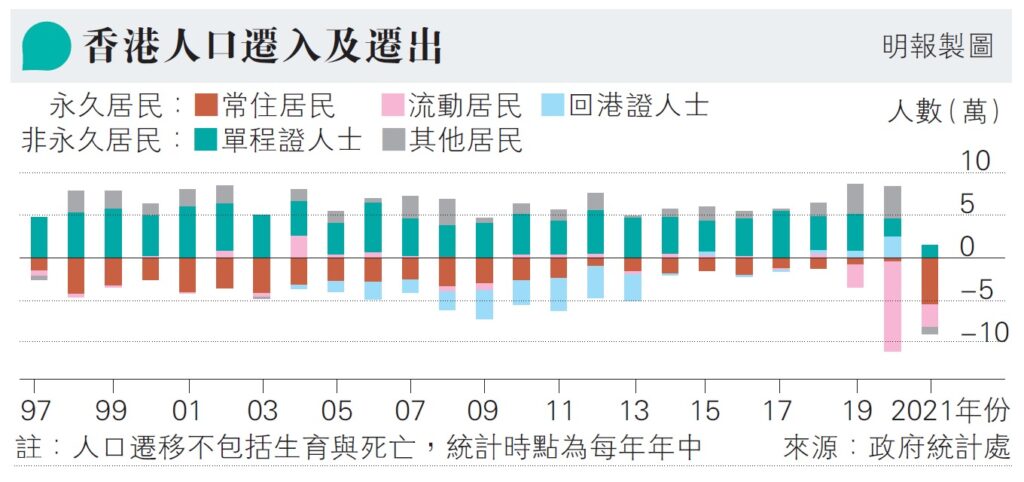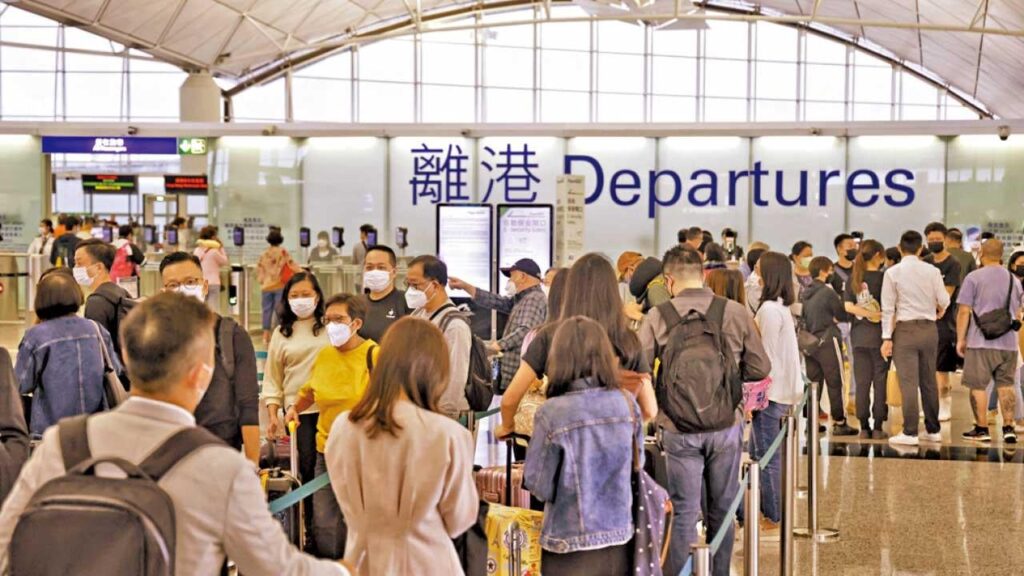Counting the scale of immigration waves
After the political changes, Hong Kong is no longer the same. Foreign countries have taken advantage of this situation to tailor-make new visa channels, making whether to leave or stay become a decision that is close to many people's eyes. Coupled with the COVID-19 epidemic, some people have left Hong Kong to avoid the epidemic. In the middle of last year, Hong Kong's net emigration exceeded 75,000, a record high; last month, Hong Kong's net emigration exceeded 65,000, which was also a new high after the implementation of travel restrictions. The media's search for stories of people living in foreign lands and the images of relatives and friends farewelling at the airport have become evidence of the reappearance of the immigration wave in the eyes of many people. They ask in their hearts: If a large number of Hong Kong people leave Hong Kong, will this still be the original city? There are three related phenomena worth clarifying in this question: how large the exodus is, whether they originally belong to the city, and whether the immigration situation will continue.

The departure of permanent residents from Hong Kong reached a new high last year. The vision of "returning people's hearts" sounds the alarm
Measuring the scale of immigration has always been a demographic problem, because residents leaving Hong Kong include Hong Kongers, mainlanders, foreigners, etc., and the number of departures also includes common reasons such as business, tourism, and study abroad. In order to deconstruct the changes in population migration, the author obtained the population migration composition figures from the Statistics Department as of mid-2021. This data integrates individual certificates and entry and exit records of various documents, and is quite accurate. As shown in the attached picture, Hong Kong residents can be divided into five categories: permanent residents, mobile residents, one-way permit holders, return permit holders, and other residents. The numbers reflect the increase or decrease of each resident category, with positive numbers indicating in-migration and negative numbers indicating emigration.
The permanent residents and floating residents here only include permanent residents, so the sum of the two is closer to the "Hong Kong people" as understood by the public. The vast majority of Hong Kong residents are permanent residents, which means they stay in Hong Kong for more than half of the year. The migration situation of this group of people is most consistent with the immigrant population that most people talk about. Since the handover, the number of permanent residents has only fallen but not risen, because the only rising factor is the return of Hong Kong residents on a limited scale. One year after the storm over the amendment bill, the movement of permanent residents has almost stopped, which has historically been rare. It is believed to be related to the paralysis of social movements in airports and the out-of-control epidemic in Europe and the United States. In 2021, permanent residents will leave Hong Kong one after another, reaching a new high of 55,000, sounding the alarm for the vision of "returning people's hearts".
There have always been about 200,000 "Hong Kong people" with permanent resident status who are mobile residents. They usually have another place of residence and stay in Hong Kong for less than half of the six months but more than one month. Migrant residents mainly live in the Mainland and Macau. They are working adults or retired elderly people. Most of them travel to Hong Kong from time to time for business, work, family visits or medical treatment. Some of them shuttle regularly between the two places, such as going north from Monday to Friday and returning to Hong Kong on weekends. In addition, some of them live overseas, including businessmen coming to Hong Kong on business trips and international students returning to Hong Kong for vacation. The population migration of migrant residents has been relatively stable, almost unabated; however, it has declined significantly in the past three years. In 2020, about 106,000 people even recorded leaving Hong Kong, with more than half of them evaporating off a cliff, which is nearly one percent higher than the new immigration high mentioned in the previous paragraph. Times!
Immigrants not coming to Hong Kong create gap
Most Hong Kong residents with Mainland background come from cross-border families. The attached figure is subdivided into one-way permit holders and re-entry permit holders. The former applies to come to Hong Kong based on family reunion and is a non-permanent resident; the latter is mainly a "double non-infant" and is a permanent resident. Due to the quota system, the inflow of new immigrants is very stable, because the border closure has only been significantly reduced in the past two years. After the "double non-fee" was cut off, the wave of departures of people with re-entry permits that had been maintained for 10 years disappeared. Until 2020, the number of immigrants surged, which may be related to the fact that cross-border students have come to Hong Kong to attend classes.
The last category is other residents, most of whom stay in Hong Kong on work visas and student visas, including outstanding talents from the mainland and foreign countries. Their stay is most affected by economic conditions. The years with the lowest number of immigrants were mostly at the trough of Hong Kong's GDP (gross local product), which is closely related to the events that occurred during the same period: SARS, the financial tsunami, the European debt crisis, Brexit and the populist black swan. After the outbreak, foreign chambers of commerce criticized the travel ban as being too strict, causing some companies to consider moving their Asian headquarters out of Hong Kong. The European Union Office in Hong Kong also reported that more than 10% of expatriates have left Hong Kong. In the past two years, such residents have changed from moving in to moving out, which reflects that Hong Kong's status as an international city has also been severely hampered by the epidemic.
From the entry and exit records of citizens, we have three observations. First, many people have tried to estimate the scale of the immigration wave last year, and 55,000 people would be a more reliable figure. This number of immigrants is much higher than that of Good Citizenship Certificate applications. Because it is defined based on the length of absence from the country, reasons such as long-term travel, overseas study, and working abroad are all taken into account. It also includes Hong Kong residents with foreign rights of abode. Therefore, Since the return of China, the number of immigrants has averaged 25,000 per year.
Second, citizens who live in Hong Kong intermittently choose to leave Hong Kong. It is believed that they return to their place of origin, the mainland, due to immigration restrictions. Only a small number of them are in Macao and overseas regions. The total emigration in 2020 became the highest in the history. The biggest reason is not to immigrate to foreign countries, but to go north to avoid the epidemic.
Third, the focus of public opinion is on the population loss in 2021. In fact, the situation will be more serious one year earlier. This is because the total in-migration of mainlanders and foreigners offset the total out-migration of immigrants and people seeking refuge from the epidemic, making the net out-migration not conspicuous. .
Signs of various types of citizens leaving Hong Kong have taken shape in the past two years. How long the situation will last is a matter of the future and needs to be speculated from the change in mentality. Democratic Thinking commissioned the Asia-Pacific Institute of CUHK to conduct a "One Country, Two Systems" index survey to track citizens' immigration mentality over a long period of time. The survey shows that citizens planning to immigrate have increased since the storm of the amendment bill, and immediately following the news of the legislation of the "Hong Kong National Security Law", it has risen to a peak of 34.5% in June 2020, and has remained high despite a series of law enforcement actions against political demonstrations. More than a year. The Election Committee and the Legislative Council completed their first elections after reforming the electoral system, radical politics retreated, and citizens' confidence in mainland-Hong Kong relations and a high degree of autonomy was restored. Immigration intentions plummeted to 23% in January this year. Citizens who have no intention of immigrating showed the opposite trend, rising from the lowest point of 58.4% in the middle of last year to 65.7% in January this year. The idea of immigration inspired by the series of unrest over the extradition bill began to recede at the beginning of this year.
The new wave of immigration may last for two to three years
The immigration mentality seen in the poll has increased since mid-2019, but the actual immigration records only emerged in 2021. The time gap between the two is about two years. This means that the immigration phenomenon requires a lot of time from the initiation of ideas to implementation. Time to prepare. People's willingness to immigrate has started to decline since the beginning of this year, and will be reflected in the number of people leaving Hong Kong with a lag. Therefore, this wave of immigration may last for two or three years. At the same time, when the epidemic is under control, border crossings resume as normal, and the economy begins to recover, Hong Kong people's mainland relatives will reunite across the border, Hong Kong people who have lived in the mainland for a long time will come back to stay, and overseas talents will return to Hong Kong, which will offset the increase in overseas immigrants. drain.
Hong Kong's recent population loss is caused by multiple factors, including returning to the mainland to escape the epidemic, the suspension of new immigrants coming to Hong Kong, limited economic opportunities, and of course, overseas emigration. Citizens voting with their feet is undoubtedly a protest against the governance situation and questioning the future prospects, but it is also like "it will rain, and the mother wants to get married." Even if it is a pity, one can only respect personal wishes. The long-term anti-epidemic life has caused us to lose too much. The wave of departures from Hong Kong will be the most urgent step after returning to normalcy, because the people in this city are the soul of this city. Hong Kong will no longer be able to cope with the epidemic. We cannot afford the original urban vitality, pioneering spirit and cultural heritage to disappear little by little.
The author Pan Xuezhi is co-convenor (research) of Democratic Thinking and Chen Huiying is senior research director of Democratic Thinking



